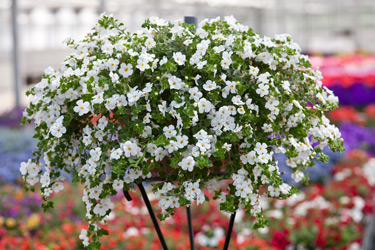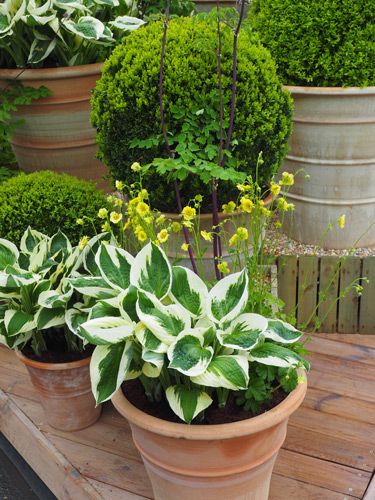Soft furnishings
As summer rolls in it's time to brighten outdoor living areas and there’s no simpler way to create a welcoming alfresco sanctuary than filling some well placed pots with your favourite flowers and foliage.
What makes a great container plant?
Almost anything will grow in a container if given the right level of care, but some plants are more tolerant of pot life than others. Plants with drought tolerance
in their breeding are the most forgiving of lapses in watering. Those that insist on perfect drainage will perform better in potting mix than heavy soil.
Choose plants that are worthy of the pride of place their container bestows on them. They might have a super long-lasting display of colour or an especially appealing shape. Ideally both! At this time of year garden centres offer an exciting array of flower packed plants with tidy, pot-perfect growth habits.
Rather than flowers, beautiful foliage may be the main event, as is the case with dry-loving succulents, swishy grasses, colourful heucheras and soft leafy hostas. Shapely evergreen shrubs hold the fort all year round, the most famous of these being clipped English box. NZ native alternatives which respond well to shaping include many different corokia and coprosmas with interesting foliage.
What makes a great plant container?
Life in a pot can be tough. When container plants run out of water, food or space to grow, they can’t just spread their roots like a plant in the ground, so they’re completely at the mercy of their gardener. But as long as your vessel is large enough and has adequate drainage it has great potential as a place to grow plants. The role of the container and its potting mix is to hold enough water and nutrients to keep plants happy while letting the excess water drain away.
The smaller the pot, the more often you will need to water. Err on the large side, especially when planting fast growing perennials, vege plants and fruit trees. Hanging baskets are particularly vulnerable to drying out if too small. On the other hand a pot that’s too big for its plant may be a waste of potting mix and nutrients or worse, lead to cold damp conditions that cause root rot. This applies to the likes of orchids and houseplants. As a guide, the new pot should be 3 to 5cm wider than the old one.
Terracotta pots are both practical and beautiful. Their porous baked clay walls may lose water more quickly than a plastic equivalent, but they also allow plant roots to breathe and so they’re less likely to overheat or become waterlogged than a plastic pot.
For ideas for great container plants go to 'Plants for summer pots'.
Taking care of container plants
Plants thrive in warm well-drained potting mix, but to remain healthy they need a little more watering and feeding than the average garden plant. Top quality container mixes give a balanced blend of ingredients designed to combine optimum drainage with best possible water holding capacity. Most also contain controlled release fertiliser to get plants off to a healthy start.
Feeding
Plants in pots need more frequent feeding than those growing in the ground. Feed little and often with liquid fertiliser or use controlled-release fertiliser. Concentrated powdered fertilisers are best avoided for plants in pots as they can burn roots. Quick growing annuals respond well to frequent feeding with liquid fertiliser, but make sure your potting mix is moist before applying.
Watering
In summer, daily watering is the necessary norm for plants in pots. In very hot dry weather you may need to water twice a day, especially when its windy. Windy weather accelerates water loss through leaf and pot surfaces.
Saving summer water
Choosing drought tolerant plants is a great place to start if you want to water less over the hot summer months. The next trick is to slow down water loss by evaporation. Hot summer temperatures and air movement conspire to strip moisture from plant and pot surfaces, so its best to avoid windy locations, especially for hanging baskets.
Pots grouped together can shelter each other. The choice of pot will also make a big difference; big is generally better when there is a need to conserve water. It might be time to swap all those little pots for a few larger ones. Its worth setting up fixed irrigation drippers, especially if you have a lot of pots. If pots are grouped together, it’s easy to run a hidden length of irrigation tubing behind them.
Wetting agents, such as Saturaid help water to spread throughout the potting mix rather than washing straight through. Top quality potting mixes often contain wetting agent. Otherwise you can mix it in yourself.
Glazed and plastic pots hold water for longer than porous clay pots. For large pots a covering layer of pebbles helps slow evaporation from the surface of the potting mix. Sphagnum moss can hold up to 20 times its own weight in water and makes a very good liner for hanging baskets.
Water saving tips
- Choose drought tolerant plants.
- Avoid windy locations, especially for hanging baskets.
- Use fixed irrigation. If pots are grouped together, it’s easy to run a length of irrigation tubing to them.
- Add a wetting agent, such as Saturaid to your potting mix. This helps water to spread throughout the potting mix rather than washing straight through. Top quality potting mixes often contain wetting agent.
- Line hanging baskets with sphagnum moss, which can hold up to 20 times its own weight in water.

1-Oct-2018

Dreamerias

Bacopa White Wedding is great in pots and hanging baskets

Hostas and buxus enjoy life in big terracotta pots.

